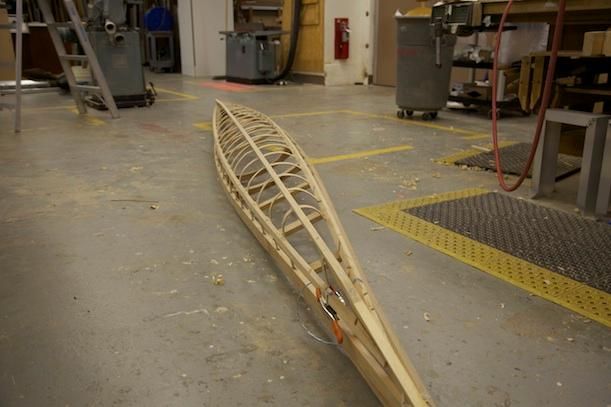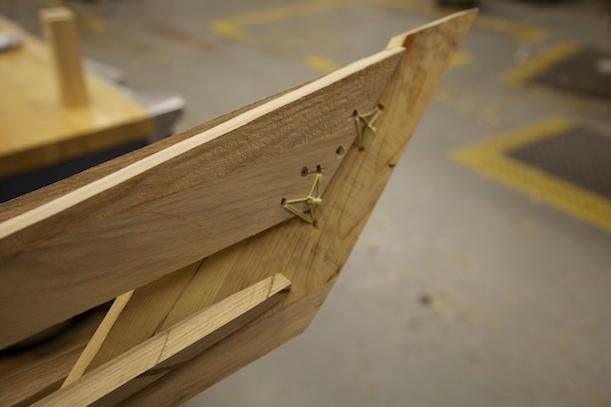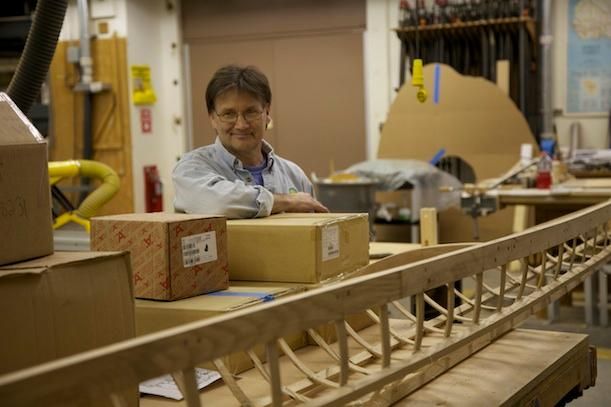How to Build a Greenland Kayak from Scratch
A Smithsonian builder takes on the challenge of crafting a kayak following a 4,000-year-old tradition
/https://tf-cmsv2-smithsonianmag-media.s3.amazonaws.com/filer/20130618015039Stoy-and-Kayak1.jpg)
Stoy Popovich never has ridden a kayak before, but that isn’t stopping him from building one.
As the National Museum of Natural History’s exhibit specialist, he creates displays and builds objects needed for the museum’s exhibitions, and when he learned the museum wanted a model of a traditional kayak used by Native hunters in Greenland, he jumped at the opportunity to piece one together.
“The project excited me because it was something new, something I’ve never done before,” he says.
The museum plans to suspend the completed kayak alongside Phoenix, its iconic model of a right whale for the reopening of “Living on an Ocean Planet,” an exhibition in the museum’s Ocean Hall about humanity’s evolving relationship with the world’s oceans. Greenland’s Inuit populations have built kayaks for thousands of years because their sleek, stealthy design makes them ideal for sneaking up on prey like seals, walruses and whales while navigating mazes of icy water.
While today the boats are most commonly used for recreation and competitions, some communities in northern Greenland continue to rely on them for hunting. Unlike popular plastic and synthetic models, Greenland’s traditional kayaks are made of a skeletal wooden frame lashed together with seal sinew and covered in sealskin. These materials make the boats light and pliable, so they are easy to cart around and capable of withstanding blows in tumultuous seas.
Popovich began the project in the winter by poking around online for instructional videos and booklets about traditional kayak building. He also consulted with Maligiaq Padilla, a Greenland National Kayaking Champion who made and donated a kayak to Smithsonian in 2005 (exhibit the kayak is problematic because it is susceptible to fluctuations in humidity).
With limited funds for the project, Popovich got creative, scavenging supplies from around his shop. For the frame, he found sheets of ash, a highly malleable wood; to tie everything together, he dug up some high tension string. He has yet to choose a fabric for the kayak’s exterior (sealskin wouldn’t be an option even if it were lying around the museum because of ethical concerns).

The materials may not be authentic, but the process certainly is. Northern Greenland doesn’t have too many trees, Popovich points out, so Native hunters spent centuries before global commerce building their kayaks from whatever wood washed ashore around their homes—usually conifers like cedar, which is harder to mold than ash but lighter and more durable.
“We’re following that tradition,” Popovich says. “This has been a grassroots, pick-myself-up-by-my-bootstraps, how-the-heck-do-I-do-this kind of endeavor.”
While an experienced builder would need less than a week to make a kayak, he has taken his time, working around other projects and making sure everything is done correctly. “Every step I stop and think, okay, what’s the best way to get through this?” he says.

So far, he has nearly completed the frame by setting the keel (the straight wooden piece that runs along the kayak’s underside), soaking and molding the ribs, shaping the gunnels (the uppermost side pieces) and lashing everything together with the high tension string. The frame is customized to Popovich’s own dimensions, as practiced in the Arctic to ensure a tight seal around the opening in the kayak to fit the person’s body to keep from water coming in and to ensure optimal control.
“These things are made by the person who’s going to be paddling it, because when you’re in it, you actually become part of the kayak. Your legs and your body work with the kayak to maneuver it,” he explains.
His next major step will be “skinning” it with whichever material he chooses.
William Fitzhugh, director of the museum’s Arctic Studies Center, says the kayak will contribute to an increased anthropological focus in the exhibit, where it will be on display with a full-scale mannequin riding it. The exhibition will emphasize how connected we are to the oceans, and how greatly we can effect them with pollution and over-fishing.
“The kayak is the perfect representation of sophisticated technology developed by people who lived in a very harsh environment. They developed a craft that would be suitable for sustaining their cultures over thousands of years,” Fitzhugh says. “It’s a very small, fragile thing, but it’s very adaptable. It was one of the most ingenious watercraft ever developed anywhere in the world.”
Popovich, who considers himself a wood specialist, has been building things for the Smithsonian in different jobs for more than 25 years. He still gets a deep satisfaction out of completing projects, though, and couldn’t hide a grin as he moved the kayak around the shop for photographs. “When it’s finished, it will be a beautiful thing,” he says.

/https://tf-cmsv2-smithsonianmag-media.s3.amazonaws.com/accounts/headshot/paul-bisceglio-240.jpg)
/https://tf-cmsv2-smithsonianmag-media.s3.amazonaws.com/accounts/headshot/paul-bisceglio-240.jpg)